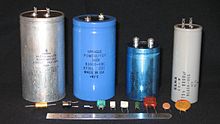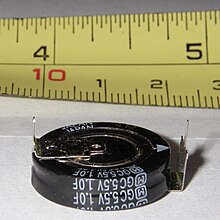Farad


The farad (symbol: F) is the SI unit of capacitance. It is named after the British physicist Michael Faraday.
Definition
The farad is defined as the amount of capacitance for which a potential difference of one volt results in a static charge of one coulomb. It has the base SI representation of s4 · A2 · m-2 · kg-1. Since an ampere is the rate of electrical flow (current) of one coulomb per second, an alternate definition is that a farad is the amount of capacitance that requires one second for a one ampere flow of charge to change the voltage by one volt. Further equalities follow:
Explanation
Since the farad is a very large unit compared to typical requirements in electronic devices, values of capacitors are usually in range of microfarads (μF), nanofarads (nF), or picofarads (pF). The picofarad is sometimes comically called a "puff", as in "a ten puff capacitor". A micro-microfarad (μμF) as found in older texts is the same as a picofarad. The millifarad is rarely used in practice, so that a capacitance of 4.7×10−3 F, for example, is usually written as 4700 µF. North American usage also avoids nanofarads. A capacitance of 1×10−9 F will frequently be indicated as 1000 pF. A capacitance of 1×10−7 F will frequently be indicated as 0.1 μF. Very small capacitance values, such as those used in integrated circuits may also be expressed in femtofarads, one femtofarad being equal to 1×10−15 F. A new technology called supercapacitors offers devices up to the kilofarad range.
The farad should not be confused with the faraday, an old unit of charge nowadays superseded by the coulomb.
The reciprocal of capacitance is called electrical elastance, the (non-standard, non-SI) unit of which is the daraf.
A capacitor consists of two conducting surfaces, frequently referred to as plates, separated by an insulating layer usually referred to as a dielectric. The original capacitor was the Leyden jar developed in the 18th century. It is the accumulation of charge on the plates that results in capacitance. Modern capacitors are constructed using a range of manufacturing techniques and materials to provide the extraordinary wide range of capacitance values used in practical electronics applications from femtofarads to farads and voltage withstand capabilities from a few volts to several kilovolts.
One picofarad is about the smallest value of capacitor available for general use in electronic design, since smaller capacitors would be dominated by the parasitic capacitances (stray capacitance) of other components, wiring or printed circuit boards. When requiring capacitance values of 1 pF or lower, engineers sometimes create their own capacitors by twisting two short lengths of insulated wire together.[1][2]

